- Home
- Bertolt Brecht
Bertolt Brecht: Mutter Courage und ihre Kinder 7 Page 32
Bertolt Brecht: Mutter Courage und ihre Kinder 7 Read online
Page 32
8*
Weeks have elapsed. Deep in the wintry plains of the Russian empire Hitler’s good soldier Schweyk is marching to join his unit near Stalingrad, where it is supposed to combine with other sections of the Nazi army in holding back the Red Army’s terrible assaults. As a result of one of his numerous misadventures he has lost contact with the rest of his draft. Untroubled by geographical preconceptions, however, and in his usual blithely trusting frame of mind, he is marching towards his allotted destination wrapped in a great bundle of assorted articles of clothing to keep out the cold. A semi-demolished signpost says that Stalingrad is 100 miles off.
While he is thus marching to Stalingrad the Chalice keeps looming up in a rosy light before our good Schweyk’s eyes. He pictures to himself how young Prochazka lives up to his promises. The man’s love of the landlady has overcome his fear of the Gestapo, and to her agreeable surprise he hands Mrs Kopecka two pounds of pickled pork for Schweyk’s unfortunate friend Baloun.
* The stage is divided in two.
As he battles courageously against the icy blasts of the steppes the indefatigable and utterly well-intentioned Schweyk becomes uncomfortably aware that he is getting no closer to his goal. The further he marches, the greater the distances shown on the signposts to Stalingrad, where Hitler so urgently needs him. A thousand miles away Anna Kopecka may at this moment be singing her ‘Song of the Chalice’, that homely and hospitable place. The voracious Baloun’s long-awaited meal will have developed into a wedding feast for the landlady and young Prochazka.
Schweyk marches on. The blizzards on those interminable eastern steppes, where the distance to Stalingrad always remains about the same, cloak the sun by day and the moon by night from the view of the good soldier Schweyk, who set out to give the great Hitler a helping hand.
Epilogue
It is likewise deep in the eastern steppes that the good soldier Schweyk personally encounters his Führer Hitler. Their conversation in the driving snow is brief and almost entirely swallowed by the storm. The gist of this historic conversation is that Hitler is asking Schweyk whether he knows the way back.
[GW Schriften zum Theater 3, pp. 1186-96. Dated New City, May 1943. This preliminary summary of the story was made for Kurt Weill, and it contains some differences from the final text. Thus the interludes balance more neatly; there is no interlude after scene 2; and Goebbels appears instead of von Bock. This is the only version which makes Prochazka a music student (scene 3) and has Schweyk preparing for an attack of rheumatism (scene 7). It omits the Chaplain and the singing of the ‘German Miserere’, and the ending is unlike that of any of the scripts.]
STAGING
The Chalice bar in Prague forms the centre of the set. Black oak panelling, bar with brass fitting, electric piano with a transparent top in which the moon and the flowing Moldau can appear. In the third act only a part of the Chalice appears to Schweyk in his thoughts and dream: his own table. Schweyk’s ‘Anabasis’ shown in this act; move in a circle around this part of the Chalice. The length of his march can be indicated by such devices as having the peasants’ hut roll forwards or backwards, growing larger or smaller in the process.—The interludes should be played in the style of a grisly fairy tale. The whole Nazi hierarchy (Hitler, Goering, Goebbels) can appear in all of them (plus Himmler and von Bock as the case may be). The satraps can accentuate the verses with shouts of ‘Heil!’
[Note ‘Zur Inszenierung’ appended to the text of the play in GW5, p. 1995.]
Editorial Note
1. GENERAL
Brecht’s Schweik play derives from Jaroslav Hasek’s novel The Adventures of the Good Soldier Švejk [or Schweik] in the World War, or more precisely from its German translation by Grete Reiner, which was first published in 1926 and from then on remained one of Brecht’s favourite books. It was promptly dramatized by Max Brod, the Prague German writer who was responsible also for the publication of Kafka’s posthumous novels, and by the German humorist Hans Reimann. The resulting play was one of those chosen by Erwin Piscator for his first season with his own company in Berlin in 1927-8, when Brecht was one of his team of dramaturgs, and because it seemed far too conventional and static for the form of production which Piscator had in mind, which was to make use of a treadmill stage and George Grosz projections, it was radically overhauled by this team. In Brecht’s own mind he himself was the main author of the Piscator version of this play; thus according to The Messingkauf Dialogues ‘he did Schweik for him entirely’. However all other accounts give Piscator’s principal dramaturg Felix Gasbarra (whom Brecht did not like) an equal or even greater share in the new adaptation, and there is nothing in Brecht’s papers to bear him out, beyond his pencilled title-page to the script: ‘Adventures of the Good Soldier Schweik. / Brecht, Gasbarra, Piscator, G. Grosz.’ Nor, so far as we know, did either he or his editors ever contemplate publishing it among his own works, even though these contain a number of adaptations, in several of which he had collaborators. It first appeared in 1974, in Herbert Knust’s Materialien zu Bertolt Brechts ‘Schweyk im zweiten Weltkrieg’ (Suhrkamp-Verlag, Frankfurt), which gives a much fuller account of the play’s evolution than we can do here.
Brecht’s copy was probably sent him from Russia by Piscator in the early 1930s—Knust points out that it is on Russian paper—when there was some question of the two men collaborating on a script for Mezhrabpom-Film. It differs from the Brod–Reimann version above all in its attempt to match the ‘epic’ and picaresque form of Hasek’s unfinished masterpiece. In his journal Brecht termed it a ‘pure montage from the novel’, though in fact it incorporated some of the earlier version and was performed under the original adaptors’ names (since they held the rights and were prepared to accept this arrangement). Briefly, its first part, corresponding to the novel’s part I, is divided into the following short scenes (the numbers of the relevant chapters in the book being given in brackets): 1. [1] At Schweik’s. / 2. [1] At the Chalice. / 3. [7] At Schweik’s (where he determines to volunteer). / 4. [7] Street scene (with Schweik in the wheelchair shouting ‘To Belgrade!’). / 5. [8] Recruiting office (medical inspection). / 6. [8] Military hospital. / 7. [8] Streets in Prague (with Schweik under arrest). / 8. [9] Transformation scene: detention room, chapel, and sacristy. / 9. [14] Lieutenant Lukaš’s rooms (Katz, the chaplain, loses his batman at cards). / 10. [14] The same (where Schweik fulfils the lady’s wishes). / 11. [14] The same (preparatory to the stealing of the dog). / 12. Street in Prague (Schweik and sapper Voditchka as dog thieves). / 13. [3 of part II] The same (Voditchka making anti-Hungarian gestures). / 14. [15] Barrack square (the colonel recognizes his dog and packs Schweik and Lukaš off to the front).
The second part, drawn from parts II and III of the novel, is in a slightly confused order (e.g. the numbering of the second scene) and differs from the staged version in its ending. (Piscator himself recounts that his team suggested various alternatives, but that he finally settled for Gasbarra’s idea, based on Cadet Biegler’s dream in the original, of a scene in heaven with Schweik and war wounded parading before God; when this proved under-rehearsed however it was changed for the parting scene between Schweik and Voditchka, who agree to meet ‘at six o’clock after the war’.) Again, the scenes are as follows: 1. [II/1] Transformation scene: in the train, changing to the station police office at Tábor. / 5. [II/2] Film, with Schweik marching (the start of Schweik’s ‘Anabasis’) and episode with the herdsman. / 2. [II/2] Transformation scene: country road, then Putim police station, then film. / 3a. In a troop train (about Baloun and his hunger). / 3b. Schweik rejoins his unit. / 3c. [III/2] In the train (where Baloun has eaten the sardines). / 3d. [III/3] Beside the railway track (with Baloun doing physical jerks). / 3c [III/2] Other side of the train (with Schweik made to do the same). Schweik here tells the 4268 episode as a story. / 4. [III/4] Battlefield. (He gets lost, puts on Russian uniform and is taken prisoner by a Hungarian unit of his own army. A shell bursts, and he is killed.) Though the typescript finishe
d here, Knust’s Materialien volume follows this with the closing scene which Brod wrote for Piscator after discussion with him and the dramaturgs. Called ‘Schweik in Heaven, An Epilogue’, it consists of two parts, the first of which shows the entrance gate guarded by an angelic sentry, with a crowd of mutilated soldiers of all nations trying to get in. Among them are Schweik and Marek, who get through only by jumping on to the back of a general’s staff car. Part 2 then shows them being marched before the Supreme Commander, who finally accepts Marek as ‘a good honest atheist’ but rejects Schweik on the grounds that ‘the fellow will simply put a spanner in any works’. He is packed off back to earth, where he arrives just in time to keep his rendezvous with Voditchka in the Chalice.
In returning to this material with a view to reworking it for the Second World War, Brecht found little that he could incorporate as it stood. Discussing his plan with his son on his return from New York at the end of May 1943 he realized that he was changing Schweik’s character by allowing him to risk frequenting so dangerous a pub as the Chalice (which figures little in the book), and sacrifice himself for the sake of Baloun. ‘That indeed is where the situation is sharper than in 1914’, he noted in his journal for 27 May, where he reports that he had been re-reading the novel in the train on the way back:
once again i was overwhelmed by hasek’s vast panorama and the authentically un-positive point of view which it attributes to the people, they being themselves the one positive element and accordingly incapable of reacting ‘positively’ to anything else. whatever happens schweik mustn’t turn into a cunning underhanded saboteur. he is merely an opportunist exploiting the tiny openings left him.
He had already written the ‘Story’ for Kurt Weill before leaving New York, and it seems that he soon showed this to Eisler, who commented that Schweik could not be seen as a typical ‘little man’ and suggested that Brecht’s play ought to end with him leading Hitler to Stalingrad, not back home. Another diary entry, of the 29th, shows that he also discussed it with Peter Lorre, whom he evidently had in mind for the title part, while again on 12 July when the first rough version was already complete, he noted that
the language of the play differs substantially from that of the german hasek translation. south german elements have been worked in, and in various ways the gest is different. so it would be wrong, e.g., to speak bohemian dialect in this play; in other words the tone of voice shouldn’t be bohemian-german.
Scene 2 of the first part of the Piscator adaptation is the only one to have survived in recognizable form, and even there Brecht changed the sex of the landlord Palivec, turning him (doubtless for Lotte Lenya’s sake) first into Mrs Natonek, then changing her name to Kopecka. Most of Hasek’s characters, too, he abandoned, so that aside from a brief glimpse of Father Lacina (the less interesting of Hašek’s two disgraceful chaplains) only Baloun and the police agent Brettschneider appear with Schweik in the play; all other characters are Brecht’s or belong to history. But the basic concept and a number of subsidiary situations or elements were transplanted into the new terms: the stealing of the dog for instance, Baloun’s embarrassing appetite, the incident of waggon 4268, the notion of an ‘Anabasis’ with its semi-conscious loss of orientation, and above all the whole Schweikian approach to authority, patriotism and war. Though the songs were mainly Brecht’s, three of Schweik’s chants are taken from the book—‘He stood beside his gun’ (p. 119) from II/2; ‘When we marched off to Jaromiř’ (p. 124) from III/4 (Piscator II/5); and ‘When Hitler sent for me’ (p. 126) from I/8 (Piscator I/7)—while Baloun’s ‘Beseda’ song (p. 107) can be found in III/4, where it is described as ‘the song the Czech regiments sang when they marched and bled for Austria at Solferino’. And despite what Brecht says, Schweik’s whole way of speaking derives from the novel. If at times it resembles that of Mother Courage, or Matti (in Puntila), or even Galy Gay (in Mann ist Mann: another part which Brecht identified with Lorre), this is only because they too in some measure reflect the same source.
The new play was at first simply called Schweyk, the phrase ‘in the Second World War’ making its appearance as an addition on the title-page of what seems to be the latest of the four versions in the Brecht Archive. The other three of these all date from 1943 and consist of a bound copy in Brecht’s typing, dated Santa Monica, July 1943; a largely identical Brecht typescript (but divided into acts and with a different ending) which he gave to Peter Lorre; and a fair copy not typed by Brecht. In summarizing their slight differences scene by scene we will refer to them respectively as the bound script, the Lorre script, the fair copy and the old Berliner Ensemble script (it bears that company’s stamp). The first printed text appeared in volume X of the collected Stücke (1958), though a duplicated stage script was available from Henschel-Verlag in East Berlin in 1956.
2. SCENE-BY-SCENE ACCOUNT
Prologue in the Higher Regions. Our text is identical with the bound script. The fair copy has a different version of the first three lines:
HITLER
My dear Himmler, forty-eight is the age I’ve now got to.
And so henceforward ‘now or never’ must be my motto.
Accordingly I’ve just decided [’to bid for world domination’, etc.].
This version ends, after ‘how does the Little Man view me?’:
HIMMLER
My Führer, he loves you—at any rate that’s the plan—much as the Little Man in Germany loves you too. The Gestapo arrange all that.
HITLER
It’s just as well they do.
—thus matching the last lines of the subsequent Interlude between scenes 3 and 4, and between scenes 6 and 7.
Scene 1. Virtually unchanged from the bound script.
Scene 2. Virtually unchanged. The report about the banker Kruscha and Bullinger’s reaction to it were additions to the first script.
Interlude in the Lower Regions. Is in the bound script but not in the Lorre script, the fair copy, the old Berliner Ensemble script or the duplicated stage script.
Scene 3. The fat woman is an addition by Brecht on the bound script, which remained virtually unchanged.
Interlude in the Higher Regions. Unchanged. In the Lorre script this begins Act 2.
Scene 4. One or two cuts have been made since the bound script, notably a characteristic Schweyk story following after ‘Yes, the Moldau’ on p. 99. The Moritat’Heinrich schlief bei seiner Neuvermählten‘, unattributed by Brecht, who gives it as an appendix in the printed version, is by J. F. A. Kazner (1779); according to Dr Sammy McLean it is also known as ‘Heinrich und Wilhelmine’, ‘Die Geisterstimme von Mitternacht’, and ‘Der ungetreue Liebhaber’. Eisler set it to the tune of a south German folksong.
In the bound script this scene was originally followed by a second ‘Interlude in the Lower Regions’, which Brecht cut.
Scene 5. A speech by Schweyk about sabotage, added as an afterthought to the bound script, was dropped in the fair copy.
Scene 6. All through this scene the references were to the London, not the Moscow Radio. The amendment was made on the bound script, but not on the other three, nor on the duplicated stage script. Kati’s remark about Schweyk’s hat (p. 114) was an addition to the bound script, which also lacks the Song of the Moldau at the end, presumably because Brecht was still rewriting it (besides those in the other scripts, there are seven separate versions of this song). Eisler’s melody for it starts with a quotation from Smetana’s Vltava.
In the Lorre script Act 2 ends here.
Interlude in the Higher Regions. Stalingrad replaced Rostov on the bound script, and the same with the numerous references that follow up to the end of the play.
Scene 7. Virtually unchanged.
Scene 8. The drunken chaplain was originally not Bullinger’s brother but the Reverend Matz from Rosenberg. The relevant amendments were made on the bound script, but the fair copy and the duplicated stage script still have him as Matz. An ironically meant reference to alleged Russian torture chambers was also
added, and taken over into the fair copy; after which it was dropped. The price specified in Mrs Kopecka’s song ‘Come right in and take a seat’ (which was accompanied by a melody in Brecht’s characteristic notation) was 80 Kreuzers in the bound script; the final cry ‘On to Stalingrad!’ was missing; and there were a number of other even smaller changes.
Epilogue. Three of the scripts and the duplicated stage script originally had Schweyk saying of the south (p. 137): ‘But there are piles of corpses there’.
HITLER
Then I’ll push East.
SCHWEYK
Then we’ll have the British in our hair.
(We have omitted the stage directions.) This is changed to the present reading on the bound script alone; hence it seems likely (as with the references to the London Radio) that Brecht used this script for his final amendments in the 1950s. In the Lorre script (as cited in Knust’s Materialien) the ending is different from mid-scene on; thus after ‘where the front or the rear is’ [p. 136] the Führer asks:

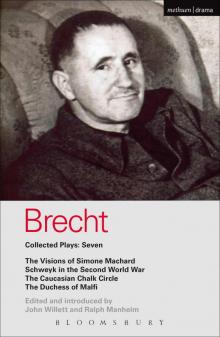 Bertolt Brecht: Mutter Courage und ihre Kinder 7
Bertolt Brecht: Mutter Courage und ihre Kinder 7 Bertolt Brecht
Bertolt Brecht Bertolt Brecht: Mutter Courage und ihre Kinder 6
Bertolt Brecht: Mutter Courage und ihre Kinder 6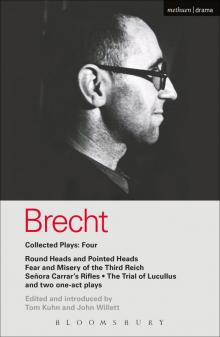 Bertolt Brecht: Mutter Courage und ihre Kinder 4
Bertolt Brecht: Mutter Courage und ihre Kinder 4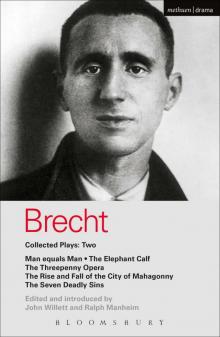 Bertolt Brecht: Mutter Courage und ihre Kinder 2
Bertolt Brecht: Mutter Courage und ihre Kinder 2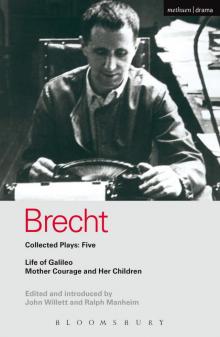 Bertolt Brecht: Mutter Courage und ihre Kinder 5
Bertolt Brecht: Mutter Courage und ihre Kinder 5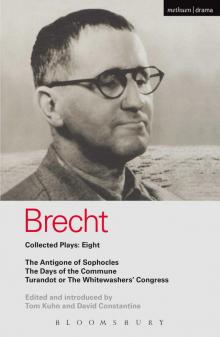 Collected Plays, Volume 4 (Bertolt Brecht: Plays, Poetry & Prose) 8
Collected Plays, Volume 4 (Bertolt Brecht: Plays, Poetry & Prose) 8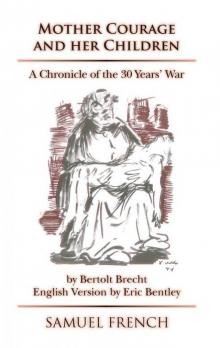 Mother Courage and Her Children
Mother Courage and Her Children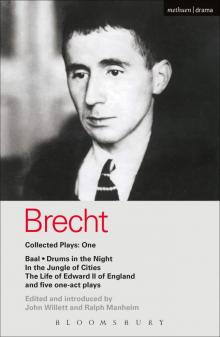 Bertolt Brecht: Mutter Courage und ihre Kinder 1
Bertolt Brecht: Mutter Courage und ihre Kinder 1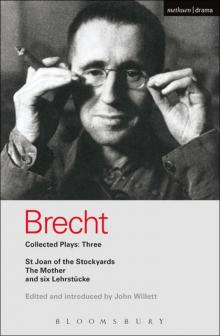 Brecht Collected Plays: 3: Lindbergh's Flight; The Baden-Baden Lesson on Consent; He Said Yes/He Said No; The Decision; The Mother; The Exception & the ... St Joan of the Stockyards (World Classics)
Brecht Collected Plays: 3: Lindbergh's Flight; The Baden-Baden Lesson on Consent; He Said Yes/He Said No; The Decision; The Mother; The Exception & the ... St Joan of the Stockyards (World Classics)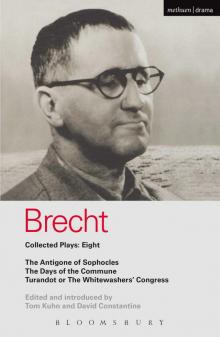 Brecht Plays 8: The Antigone of Sophocles; The Days of the Commune; Turandot or the Whitewasher's Congress: The Antigone of Sophocles , The Days of the Comm (World Classics)
Brecht Plays 8: The Antigone of Sophocles; The Days of the Commune; Turandot or the Whitewasher's Congress: The Antigone of Sophocles , The Days of the Comm (World Classics) Brecht Collected Plays: 1: Baal; Drums in the Night; In the Jungle of Cities; Life of Edward II of England; & 5 One Act Plays: Baal , Drums in the Night , In the Jungle of Ci (World Classics)
Brecht Collected Plays: 1: Baal; Drums in the Night; In the Jungle of Cities; Life of Edward II of England; & 5 One Act Plays: Baal , Drums in the Night , In the Jungle of Ci (World Classics)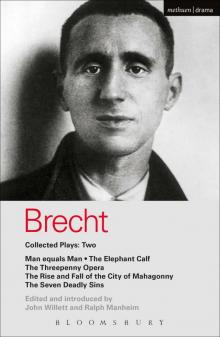 Brecht Collected Plays: 2: Man Equals Man; Elephant Calf; Threepenny Opera; Mahagonny; Seven Deadly Sins: Man Equals Man , Elephant Calf , Threepenny Ope (World Classics)
Brecht Collected Plays: 2: Man Equals Man; Elephant Calf; Threepenny Opera; Mahagonny; Seven Deadly Sins: Man Equals Man , Elephant Calf , Threepenny Ope (World Classics)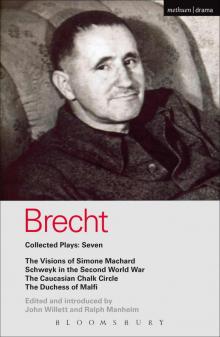 Brecht Collected Plays: 7: Visions of Simone Machard; Schweyk in the Second World War; Caucasian Chalk Circle; Duchess of Malfi (World Classics)
Brecht Collected Plays: 7: Visions of Simone Machard; Schweyk in the Second World War; Caucasian Chalk Circle; Duchess of Malfi (World Classics)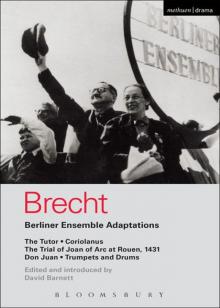 Berliner Ensemble Adaptations
Berliner Ensemble Adaptations Brecht Collected Plays: 5: Life of Galileo; Mother Courage and Her Children (World Classics)
Brecht Collected Plays: 5: Life of Galileo; Mother Courage and Her Children (World Classics)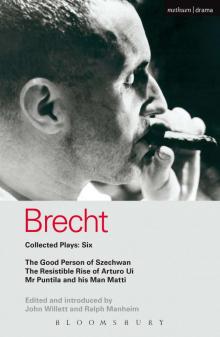 Brecht Collected Plays: 6: Good Person of Szechwan; The Resistible Rise of Arturo Ui; Mr Puntila and his Man Matti (World Classics)
Brecht Collected Plays: 6: Good Person of Szechwan; The Resistible Rise of Arturo Ui; Mr Puntila and his Man Matti (World Classics)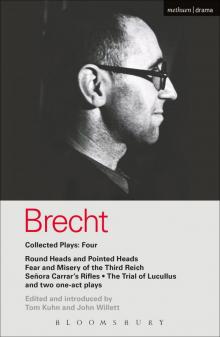 Brecht Collected Plays: 4: Round Heads & Pointed Heads; Fear & Misery of the Third Reich; Senora Carrar's Rifles; Trial of Lucullus; Dansen; How Much Is ... and Misery , Carr (World Classics)
Brecht Collected Plays: 4: Round Heads & Pointed Heads; Fear & Misery of the Third Reich; Senora Carrar's Rifles; Trial of Lucullus; Dansen; How Much Is ... and Misery , Carr (World Classics)